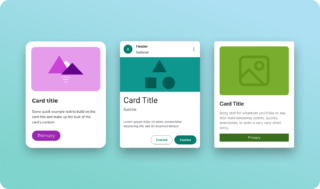Is the future of design systems global?
Part 1: The Case for a Global Design System
by Ellie Krysl

Imagine a world where every website and app you interact with feels familiar and intuitive. Buttons function the same way; navigation is predictable, and accessibility is a given. Standardized, pleasing, and intuitive experiences like those, plus a strong dash of branding are a goal for most businesses. From start-ups to well-established organizations, companies aim to provide customers with an intuitive, pleasing digital experience, because, at its core, a company’s UX is their business – at least from the perspective of their customers. But how do companies consistently achieve this? Often by implementing a design system.
Earlier this year, Brad Frost, the pioneer of atomic design, posed an intriguing question: “Why isn’t there a global design system?” According to Frost, an aesthetic and technology-agnostic global design system (GDS) has the potential to revolutionize design systems, just as design systems revolutionized UI design. Is a global design system a good idea? Definitely. But is it realistic? That depends. This series will explore the concept of a GDS, its potential benefits, its challenges, and what a GDS means for organizations now and in the future.

Before diving into the feasibility of Frost’s vision, let’s understand how we got here and why the concept of a GDS is being posed now. The rise of design systems has been nothing short of revolutionary. They have become essential tools for ensuring UI consistency, improving efficiency, and embedding best practices in design and development processes. Design systems have become the norm and their numbers are growing.
The Rise of Design Systems and the Case for a Global Approach
Design systems have gained significant traction over the last decade and it’s easy to see why. Leveraging a design system has been shown to reduce development time by 30-37%, and increase designer efficiency by 34%. Additionally, design systems enable a more consistent user experience and brand presentation, which can increase revenue by up to 23%. It’s no wonder that, according to a 2020 Forrester survey, 65% of companies used a design system, regardless of their size. And that number is expected to increase. With so many organizations creating design systems a new opportunity has appeared.
Are you trying to build buy-in for a design system at your organization? Use the previous paragraph’s statistics and sources when discussing a design system’s ROI.
The Problem with Similar Design Systems
One key focus of a design system is to provide reusable building blocks to ensure a consistent, superior user experience. This means leveraging UI best practices and well-established interaction patterns. As a result, most design systems are comprised of many of the same components and interaction patterns.

Certain components, such as buttons, tabs, navigation menus, accordions, and date pickers, are core user interface elements with well-established guidance. However, design and development teams continue to create these components for each organization’s design system. This redundancy propagates some of the issues that design systems are meant to address—rebuilding the same elements repeatedly, but now the problem is spread across companies instead of being limited to one.

Frost advocates for a shared set of unstyled base components with usability, accessibility, and interaction best practices built-in, allowing design and development to be streamlined further and freeing up specialists to focus on greater innovation. This vision is what he calls a global design system which he believes can be driven by an established worldwide body like The World Wide Web Consortium (W3C).
Benefits of Global Design Systems
At its core, a global design system represents a natural evolution in the maturity of user interface design. Builders and architects rely on standardized components, such as doors and windows. This ensures compatibility, efficiency, and easier maintenance. This standardization ensures compatibility, efficiency, and facilitates easier maintenance and updates in the future. By relying on these standardized elements, architects can devote more attention to the unique and innovative aspects of their designs. Similarly, a global design system would establish standardized UI components—such as buttons, tabs, accordions, and cards—alongside interaction patterns, thereby ensuring consistency across digital platforms. This approach empowers designers and developers to focus on creativity and innovation while leveraging a dependable set of universal building blocks.
Let’s explore the benefits of a global design system, which would include all the advantages of design systems, but with the potential to do even more.
A global design system represents a natural evolution in the maturity of user interface design.

Efficiency: Streamlining design and development processes not just within organizations, but across them.

Consistency: Ensuring a cohesive user experience globally, not just within a single product but across all digital platforms, eases users’ cognitive load and reduces the learning curve when interacting with new interfaces.

Inclusivity and Accessibility: Incorporating best practices to accommodate all users globally, including aging populations, cultures new to the internet, and those with disabilities.

Ethical Design Practices: Ensuring ethical design standards by integrating practices that prevent the use of dark patterns, which are manipulative design tactics that exploit user behavior. This is particularly important as regulations against dark patterns become more widespread.

Cost Savings: Reducing the need for redundant design and development efforts for components and interactions that are already solved, enabling teams to focus on innovation and more complex business problems.

Sustainability: A key benefit not yet discussed is a GDS’s potential to promote energy-efficient design practices by reducing redundant development across organizations and ensuring components are optimized for minimal load times and energy use.

Lower Barrier to Entry: Providing small organizations, startups, and non-profits with access to a high-quality design system without the need for extensive budgets or a dedicated design and development team. These organizations may not be able to build as many theming, customizations, or extensions on the GDS as other organizations, but they will be able to leverage the benefits of a better, more consistent user experience.

Shared Language: Solidifying a shared language across the entire industry of designers and developers, standardizing component names and token structures. This consistency improves communication, builds industry maturity, and facilitates sharing across organizations.
These are just a few of the potential benefits. However, the journey to implementing a global design system won’t be easy. In the next article, we’ll explore some of the challenges that a global design system is likely to encounter, as well as some design systems that have already made moves in this space like Google’s Material Design and the newly released Figma Simple Design System.
The idea of a technology and aesthetic-agnostic global design system is both exciting and daunting. It holds the potential to revolutionize the digital landscape but requires careful consideration and strategic planning. Stay tuned as we explore these challenges in the next article.
Explore how our UX services can help implement scalable design systems.